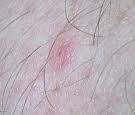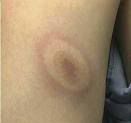We've discussed how to best avoid tick bites and today we'll discuss what to do if you been bitten by a tick.
How do you know if you've been bitten by tick? The most obvious case is that you've found a tick attached to you or someone you know. It is most often cited that the tick must be attached 36 hours for transmission of Lyme to occur, but it is possible for transmission to occur more rapidly. The first thing you need to do is remove the tick. This has to be done properly, to ensure that you really do remove the entire tick. Luckily, we have Dr. Oz to demonstrate the proper method:

Another possibility is that you see a bite, but the tick is no longer attached. How do you know if it's a tick bite? A few things to look for:
- Is it a single bite or a series of bites? With ticks, there is usually just a single bite.
- Did you think, "this might be a spider bite?" This is one of the most common mistakes. If you think its a spider bite, reconsider.
- Is there a rash? Not a welt - where the skin is raised but not red, a rash where the skin is red. A few things about the Lyme rash from the Columbia Lyme and Tick-Borne Disease Research Center:
This rash is most often circular with a clear edge, but oblong and other shaped rashes may occur as well in response to the tick bite. This rash is known as erythema migrans or EM. This rash usually starts about 3-30 days after the tick bite. Sometimes this rash is mistaken as a "spider bite". It is called "migrans" because it grows in size, gradually expanding over several days to greater than 2 inches across; some rashes can cover very large areas, such as an entire back. If the center of the rash clears, the rash may take on a bull's-eye appearance. The rash is usually not itchy or painful. Sometimes, other rashes occur in other parts of the body far away from the initial tick bite. This is because the spirochete gets transmitted quite rapidly in the bloodstream after the initial tick bite. Wherever the blood goes, there too will the Borrelia spirochete travel.There are some strong myths about the rash associated with Lyme, so I'm going to reiterate a few of the points made here:
- The rash may not be circular
- You can get the rash in more than one location, even with one bite
- The rash is not itchy or painful.
- The rash can appear several days after the initial bite.
In about 60-70% of cases, a rash may develop at the site of the tick bite.That is, 30%-40% of patients do NOT get the rash.
So, the rash is a fairly definitive sign, but never think you're out of the woods just because you don't see the rash.
A simple tick bite might look like this:

A bite with a "bull's eye" rash might look like this:

Another type of tick bite rash might look like this:

Sometimes it can even look like a bruise:

You can see, there is a wide variety of tick bite expressions. So, if you've been outside near any tall grasses, wood piles, or trees - it doesn't take much, as the ticks we most commonly acquire are carried by birds and mice and other small animals - and you see a bite which looks like any of these, you should be considering the possibility of a tick.
To be clear: Lyme Disease is now reported in all 50 states. You do not have to be in the countryside to be at risk. I acquired Lyme Disease inside Boston. Mostly likely at a nearby park, but could have been in my backyard. I know children in the neighborhood are getting it without leaving their yard.
Ok. You think its a tick bite. What now?
Go. To. A. Doctor.
Here's where it can get a bit tricky. Doctors are not necessarily well-educated about Lyme. In fact, there is lots of mis-education going on. So, you may have to insist on what you need. Frankly, you may have to go in armed with information (pdf) and you will need to have formed your own opinion about what to do. Why? Because the range of advice you can get from a doctors office is from: "don't worry about it" to "don't do anything unless we get a positive ELISA test result" to "take 1 dose of doxycycline and you'll be fine" to "its best to take a prophylactic course of 30 days of antibiotics and to continue testing."
### Opinion Alert ###
Here's where we move from me simply sharing info to me citing my own opinions based on my own experiences. Please read this with that in mind and the understanding that I am not a doctor and have never played one on television. I did play doctor as a child, but I'm sure that doesn't give me any credentials, either. ;-) I simply have had to face all of this for a long time and have become as well-educated as I can.
How do you decide what's right for you? I don't know. I can tell you how I came to my conclusions and, perhaps, others will tell you why they have their opinion on the matter. I have a long post on my BostonLyme blog about this, which I'll just summarize here with few links for your perusal:
First and foremost, in my mind, is that you need to do everything you can to avoid the very devastating possibility of acquiring "late disseminated" or "neurologic" Lyme. Just read the description, noting that "this can occur in a matter of days":
If not caught early, the infection may then spread to many other parts of the body. This can occur over a period of days, affecting the central nervous system (brain), the peripheral nervous system (nerves), the cardiovascular system (causing pericarditis and/or 2nd or 3rd degree heart block and possible death if not treated immediately), the liver (causing mild hepatitis), the eyes (causing conjunctivitis). and the muscles and joints (causing migrating swelling, tenderness, and/or pain). The typical constellation of symptoms associated with disseminated Lyme disease may include severe fatigue with a need for naps during the day, low grade fevers, muscle and joint pains, sleep disturbance, irritability, headaches, light or sound sensitivity, sharp stabbing or shooting pains, and/or numbness and tingling.For me, the risks of Lyme far outweigh the risks of 4 weeks of antibiotics.
Because this thing can disseminate so quickly, it doesn't make sense to me to wait for test results. Here, I'll quote from my blog about the problem with waiting for tests:
The initial screening test for Lyme, used quite universally, is called the ELISA. The ELISA is known to be inaccurate up to 55% of the time.(1) That is, it only correctly determines whether Lyme antibodies are present 45% of the time. At least 35% of the patients told that they do not have Lyme Disease because their ELISA test came back negative, actually do have Lyme Disease. This is called a false negative. That is to say, that the ELISA will miss over 1/3 of the cases.Do you want to rely on a test which is 55% inaccurate? Do you want to wait 8 weeks, given how quickly this disease can spread to something much more difficult to treat?
Additionally, our bodies do not produce enough antibodies to register on an ELISA screen for up to eight weeks after the onset of infection. So, to be sure that you have the best chance of an accurate test you must wait 8 weeks.
There is a lot more to say on the topics of testing, mis-education and the challenges for patients when they have to determine for themselves who to trust on such an technical matter. Lyme Disease is a complex topic in and of itself because there are different strains. It is further complicated by the prevalence of co-infections. Those docs that point to research citing that Lyme is cured in 4 weeks, are pointing to very flawed studies that do not include patients with delayed diagnosis or co-infections, for instance. The studies don't do long-term follow-up of the patients. Nor do they look at multiple medicines or the more than 100 strains of borrelia. The picture of what research has and hasn't been done gets muddied by the fact that medicine is a for-profit industry.
I wish it were more straightforward. For me, the bottom line is that acquiring Lyme is not worth any risk. Whenever I know of anyone who has been bitten I arm them with information and tell them this:
- Demand 4 weeks of antibiotics as a prophylactic
- Demand that you get both the ELISA and the Western Blot test
- Demand detailed results of the tests, not just the lab's overall assessment
- If you are still symptomatic after 4 weeks of antibiotics, demand more treatment.
- If your doctor doesn't respect your input, find one that will.
International Lyme and Associated Diseases Society
California Lyme Disease Association
Lyme Neuroborreliosis Research Program
"Learn the Truth About Lyme"
PDF of letter challenging common prophylactic recommendations
Volkman Letter about evidence of persistence, unreliability of testing, blocking of good research and much more... (pdf)
(1) Bakken LL, Callister SM, Wand PJ, Schell RF. Interlaboratory comparison of test results for detection of Lyme disease by 516 participants in the Wisconsin State laboratory of hygiene/College of American Pathologists proficiency testing program. J Clin Microbiol 1997; 35: 537-543.


How soon must you take an antibiotic after a bite?
ReplyDeleteI am not a doctor, of course, but my understanding is that you should take them as soon as you possibly can. The sooner you get the antibiotics, the better you chance you have of preventing long-term health issues.
ReplyDelete